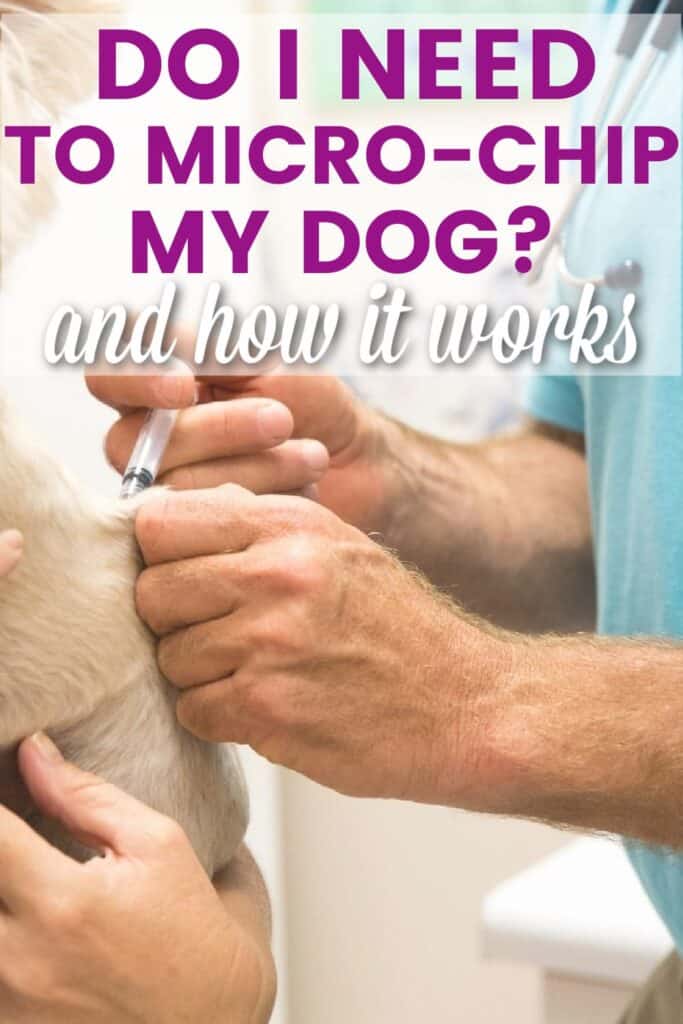Micro-chipping a dog is a reliable way to get your information in case your dog is lost, which increases the odds your pup will be returned to you as well as to get vital information about your pet.
Since their large-scale introduction years ago, microchips have seen increased usage by pet owners across the globe.
For those not familiar, micro-chipping involves injecting a small computer chip, akin to a grain of rice, under the skin of your pet.
The process is incredibly similar to a standard vaccination, and it does not carry any major risk of harm to your dog. Microchips carry a registration number that are linked to your name and contact information.
How Does A Microchip work?
It also adds your information to a large registry offered by the microchip manufacturer. A scanner can then read the information on the microchip. It equips most veterinarian offices and animal shelters with the scanners necessary to read the microchip.
Of course, the utility of microchips comes from the fact that if your pet gets lost or even stolen, then the chip can be read by anyone who finds them. Your contact information can then be retrieved and used to reunite you with your pet.
Micro chipping can be an incredibly effective tool for keeping track of your pet and keeping them safe. The following points illustrate the importance in micro-chipping your dog and keeping them safe.
Lastly, there are several manufacturers who make microchips, all with their own scanner. Scanning your pets microchip requires using that brand’s scanner, which some animal shelters and veterinarians offices may not have.
However, finding a scanner is rarely a major issue, and it can be easily solved by simply getting your vet’s recommendation as to what mico chip you should get installed. Of course, you should always speak to a vet before getting your dog micro-chipped and listen to their feedback.

What is micro-chipping, and can it be done to any animal?
A needle that contains a little chip is placed under the animal’s skin, usually between the shoulder blades. The chip itself has a unique number that can be picked up and read by a scanner.
Dogs and cats are the most common to be micro-chipped, but it can also include horses, ferrets, and most other mammals.
How long does it take and does it have to be done by a veterinarian?
No, it’s required to be done by a veterinarian, but it is a recommendation to have a veterinarian do it.
Micro-chipping is a fast and painless process. It takes about the same time to give any injection to a human being, just seconds. It can take more time to do the paperwork than implant the microchip.
Is it painful to my pet?

Not at all. It’s like having blood drawn with just a pinch. Most dog’s don’t even notice it.
Most often micro-chipping is done when your pets are being spayed or neutered.
Are Microchips Tracking Devices?
In short, no, microchips do not allow you to track your dog using a GPS-like technology.
They are simply able to be scanned and used to find your contact information, whereupon your dog can be returned to you should they be lost.
GPS devices and microchips compliment each other and are useful if your dog is lost in different ways.
A GPS device, like a dog’s collar, may tell you where your dog is, but it anyone who finds your dog won’t be able to receive your contact information to help return your dog home.
They also require batteries and can be lost.
Cons to micro-chipping my dog?
There are a few cons, albeit small, to micro-chipping your dog.
First, the process is incredibly similar to your dog receiving a vaccination, which can be a bit stressful for them. However, the risk of any real damage or complications with a microchip insertion is incredibly similar.
A microchip can also migrate away from the site of injection over time, which can make it more difficult to find and scan it later.
This requires more work on the part of the scanner to find it, but does not necessarily pose any other sort of risk.
What does it Cost to Micro-chip my dog?

Micro chipping sounds like a complex process, but it is both incredibly simple and affordable.
During the month of May, or Microchip Your Pet Month, many veterinarians offer micro-chipping for as low as forty dollars.
This is a fantastic price for such an incredibly important step to keeping your dog safe and preventing them from getting lost later in life.
The Statistics
Unfortunately, over ten million dogs a year are reported missing by owners. Even worse, a large majority of them are never returned, mostly due to an inability to contact the owner.
With a microchip, if your dog is lost, they are 2.5 times more likely to be returned to you.
Why Micro-chip a Dog or Cat?
Pet collars are typically seen as the norm, but they have a lot of drawbacks to them.
First, they can be easily lost if your pet manages to remove them. Additionally, they can also break or the information can wear off of the collar over time.
Unlike collars, microchips are permanent and cannot be removed from your pet, meaning that you can always rely on them to aid you in finding your dog.
While microchips are permanent, it is still advised that your veterinarian scans the chip at least once a year to avoid any problems should the chip malfunction.
However, you should still have a collar on your dog even if they are chipped. This could still help someone contact you about your dog, without the hassle of going to a vet or shelter.
Additionally, a collar immediately tells people that your dog is domesticated and has an owner, as opposed to a stray which could be seen more so as a threat.
Proof Of Ownership
In the event that your ownership is disputed, or if your dog is stolen, a microchip with your name and contact information almost undoubtedly proves that you are the owner of your dog.
The importance of this cannot be understated, and it can save a lot of legal hassle should the ownership of your dog ever come into question.
The importance of this cannot be understated, and it can save a lot of legal hassle should the ownership of your dog ever come into question.
It is incredibly important to keep the information on your dog’s microchip current, otherwise the microchip cannot be effective in helping locate your lost dog.
Make sure you periodically review the information on your dog’s microchip and update it as soon as possible after any changes to your contact information.
Legal Compulsion
In some countries, micro-chipping is mandatory to own a dog or other pets. Not only is it a good idea to do anyway, but it might be required if you wish to own a pet where you live.
It would be recommended to check with your area’s laws regarding micro-chipping pets, especially if you are planning on owning a dog in the near future.
As you can see, micro-chipping a dog is an incredibly important step in protecting them, and being proactive if they are lost or stolen.
While there are other steps you can take to prevent your dog from being permanently lost, a microchip can be the key factor in getting your dog rightfully returned to you, especially given how unpredictable our furry friends can be.
With few cons and so many pros, including an affordable price, it is always a good idea to speak to a vet about getting your dog micro-chipped.






Leave a Reply